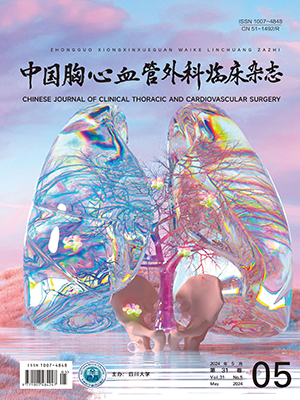| 1. |
Sung H, Ferlay J, Siegel RL, et al. Global cancer statistics 2020: GLOBOCAN estimates of incidence and mortality worldwide for 36 cancers in 185 countries. CA Cancer J Clin, 2021, 71(3): 209-249.
|
| 2. |
Zappa C, Mousa SA. Non-small cell lung cancer: Current treatment and future advances. Transl Lung Cancer Res, 2016, 5(3): 288-300.
|
| 3. |
Sands J, Tammemägi MC, Couraud S, et al. Lung screening benefits and challenges: A review of the data and outline for implementation. J Thorac Oncol, 2021, 16(1): 37-53.
|
| 4. |
Oudkerk M, Liu S, Heuvelmans MA, et al. Lung cancer LDCT screening and mortality reduction—Evidence, pitfalls and future perspectives. Nat Rev Clin Oncol, 2021, 18(3): 135-151.
|
| 5. |
Altorki NK, Yip R, Hanaoka T, et al. Sublobar resection is equivalent to lobectomy for clinical stage 1A lung cancer in solid nodules. J Thorac Cardiovasc Surg, 2014, 147(2): 754-762.
|
| 6. |
Li C, Ma X, Yang Y, et al. Thoracoscopic lobectomy versus segmentectomy in the treatment of patients with early-stage lung cancer. Evid Based Complement Alternat Med, 2022, 2022: 4376968.
|
| 7. |
罗清泉, 王述民, 李鹤成, 等. 机器人辅助肺癌手术中国临床专家共识. 中国胸心血管外科临床杂志, 2020, 27(10): 1119-1126.
|
| 8. |
Ginsberg RJ, Rubinstein LV. Randomized trial of lobectomy versus limited resection for T1 N0 non-small cell lung cancer. Lung Cancer Study Group. Ann Thorac Surg, 1995, 60(3): 615-622.
|
| 9. |
Okada M, Koike T, Higashiyama M, et al. Radical sublobar resection for small-sized non-small cell lung cancer: A multicenter study. J Thorac Cardiovasc Surg, 2006, 132(4): 769-775.
|
| 10. |
Feng J, Wang LF, Han TY, et al. Survival outcomes of lobectomy versus segmentectomy in clinical stageⅠnon-small cell lung cancer: A meta-analysis. Adv Ther, 2021, 38(7): 4130-4137.
|
| 11. |
Cao C, Chandrakumar D, Gupta S, et al. Could less be more?—A systematic review and meta-analysis of sublobar resections versus lobectomy for non-small cell lung cancer according to patient selection. Lung Cancer, 2015, 89(2): 121-132.
|
| 12. |
柴新春, 许世广, 刘博, 等. ⅠA期非小细胞肺癌行达芬奇机器人和电视胸腔镜肺段切除术近期疗效对比分析. 中华胸心血管外科杂志, 2021, 37(11): 644-648.
|
| 13. |
Zhang J, Feng Q, Huang Y, et al. Updated evaluation of robotic- and video-assisted thoracoscopic lobectomy or segmentectomy for lung cancer: A systematic review and meta-analysis. Front Oncol, 2022, 12: 853530.
|
| 14. |
Veronesi G, Novellis P, Perroni G. Overview of the outcomes of robotic segmentectomy and lobectomy. J Thorac Dis, 2021, 13(10): 6155-6162.
|
| 15. |
叶贯超, 刘亚飞, 张春敭, 等. 达芬奇机器人与胸腔镜肺段切除术治疗早期非小细胞肺癌的有效性对比. 机器人外科学杂志(中英文), 2021, 2(1): 1-9.
|
| 16. |
王述民. 机器人手术十年体会. 中华胸部外科电子杂志, 2021, 8(1): 1-5.
|
| 17. |
Bolsin S, Colson M. The use of the Cusum technique in the assessment of trainee competence in new procedures. Int J Qual Health Care, 2000, 12(5): 433-438.
|
| 18. |
赖湘敏, 刘博, 孙灿, 等. 以CUSUM方法分析达芬奇机器人肺叶切除术的学习曲线. 中华腔镜外科杂志(电子版), 2018, 11(4): 220-223.
|
| 19. |
Zhang Y, Liu S, Han Y, et al. Robotic anatomical segmentectomy: An analysis of the learning curve. Ann Thorac Surg, 2019, 107(5): 1515-1522.
|
| 20. |
Szold A, Bergamaschi R, Broeders I, et al. European Association of Endoscopic Surgeons (EAES) consensus statement on the use of robotics in general surgery. Surg Endosc, 2015, 29(2): 253-288.
|
| 21. |
Hagen ME, Meehan JJ, Inan I, et al. Visual clues act as a substitute for haptic feedback in robotic surgery. Surg Endosc, 2008, 22(6): 1505-1508.
|
| 22. |
安芳芳, 荆朝侠, 彭燕, 等. 达芬奇机器人的"前世、今生、来世". 中国医疗设备, 2020, 35(7): 148-151, 168.
|




